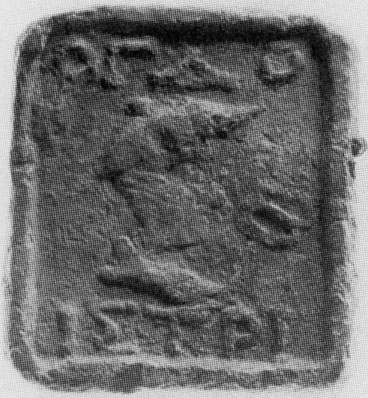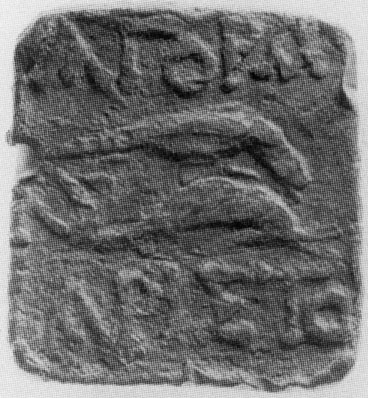
-
Copyright credit: Ashmolean Museum / Louise Willocx
-
Copyright credit: Ashmolean Museum / Louise Willocx
-
Copyright credit: Ashmolean Museum / Louise Willocx
-
Copyright credit: Ashmolean Museum / Louise Willocx
-
Copyright credit: Meyer 2001–03

-
Copyright credit: Meyer 2001–03

ARCHAEOLOGICAL DESCRIPTION OF THE WEIGHT
Authority
Aristo(– – –), agoranomos (Istros)
Mint
Istros
Denomination
1/8 Mina
Material
Lead
Manufacture
Cast
Shape
Square
Length
4.35 cm
Width
4.70 cm
Height
0.55 cm
Metrology
| Mass (g) | Mass (grain) | Date of measurement | Reference | fragmented | cleaned | reference weight |
|---|---|---|---|---|---|---|
| 85.30 | - | Sept. 3, 2019 | Autopsy Louise Willocx | No | No | Yes |
| 85.26 | - | - | Meyer 2001–03 | No | No | No |
Iconography
| Symbol | Technique | Direction | Position | Number | Synecdoche |
|---|---|---|---|---|---|
| Eagle | Relief | RIGHT | |||
| Dolphin | Relief | RIGHT | |||
| Petasos | Relief | RIGHT | |||
| Caduceus | Relief | RIGHT | |||
| Hermes | Relief | RIGHT | Head |
Wear
Lightly worn
Corrosion
Lightly corroded
Handle
No
Suspension hole
No
Recarved mould
No
Recarved weight
No
Intentionally destroyed
No
Archaeological description
Ashmolean Museum: Lead weight, Hermes wearing a petasos and carrying caduceus staff.
Meyer 2001–03: Histrian weight of the autonomous period. Square lead weight, 85.26 gr., 4.72 x 4.39 x 0.58 cm. Obv. Relief panel within raised border, showing head of Hermes r. with petasos and caduceus, ΟΓΔΟ above and lΣTPI below. Rev. Eagle on dolphin r., AΓOPA above, APIΣTO below. Edges folded in. AN 2004.18. One-eighth mina. Dents at left and upper right edges on the reverse, otherwise the piece is well preserved. As in nos. 4, 5, 9 and 21 of our group, the inscription records the name and function of the agoranomos supervising the production of this particular batch of weights. Moreover, the abbreviation API or AP appears on the Histrian bronze coins with Apollo or Demeter on the obverse, which are presently assigned to the second half of the third century BC.
Autoptic examination: Lead weight, square shape. Signs of wear and corrosion: chippings; small strokes on the sides. On the obverse, frame and depiction in relief: Head of Hermes to the right wearing a petasos hat and carrying caduceus staff. Above and below, letters in relief: ΟΓΔO and ΙΣΤΡΙ. On the reverse, depiction of an eagle on a dolphin to the right in relief. Above and below, legend in relief: AΓOPẠ and APIΣTO (in smaller letters).
Meyer 2001–03: Histrian weight of the autonomous period. Square lead weight, 85.26 gr., 4.72 x 4.39 x 0.58 cm. Obv. Relief panel within raised border, showing head of Hermes r. with petasos and caduceus, ΟΓΔΟ above and lΣTPI below. Rev. Eagle on dolphin r., AΓOPA above, APIΣTO below. Edges folded in. AN 2004.18. One-eighth mina. Dents at left and upper right edges on the reverse, otherwise the piece is well preserved. As in nos. 4, 5, 9 and 21 of our group, the inscription records the name and function of the agoranomos supervising the production of this particular batch of weights. Moreover, the abbreviation API or AP appears on the Histrian bronze coins with Apollo or Demeter on the obverse, which are presently assigned to the second half of the third century BC.
Autoptic examination: Lead weight, square shape. Signs of wear and corrosion: chippings; small strokes on the sides. On the obverse, frame and depiction in relief: Head of Hermes to the right wearing a petasos hat and carrying caduceus staff. Above and below, letters in relief: ΟΓΔO and ΙΣΤΡΙ. On the reverse, depiction of an eagle on a dolphin to the right in relief. Above and below, legend in relief: AΓOPẠ and APIΣTO (in smaller letters).
Autopsy
Yes
INSCRIPTION
| Language | Technique | Legend type |
|---|---|---|
| Greek | Relief | Authority, Denomination, Mint |
Fac simile
ΟΓΔΟ
ΙΣΤΡΙ
ΑΓΟΡΑ
ΑΡΙΣΤΟ
Edition
Ὄγδο(ον) | Ἰστρι(ανῶν) || ἀγορα(νόμου) | Ἀριστο(– – –).
Monogram
ARCHAEOLOGICAL CONTEXT
Findspot (region)
Findspot (site)
context
CIRCUMSTANCES OF ACQUISITION
Region
City
Date of first acquisition
Dec. 31, 1996
circumstances
Meyer and Moreno 2004: In 1996 a private collector of ancient coins received a posted parcel containing 43 metal objects, supposedly lead weights from ancient Istria on the western shore of the Black Sea. These came unsolicited from an antiquities dealer based outside Britain, and given that they would otherwise most likely have been dispersed on the open market, the recipient notified the Ashmolean Museum in Oxford and deposited the package at the Department of Antiquities.
DATING OF THE WEIGHT
Curatorial Section
GREEK
Time frame
FROM
-400
TO
-100
Comments on Chronology
COLLECTION HISTORY
Collection
| Name | Date of acquisition | Inventory number |
|---|---|---|
| Ashmolean Museum (Oxford) | Dec. 31, 1996 | AN 2004.18 |
Bibliography
| Reference | Page/Column | Reference (number) | Plate / Figure | Comment |
|---|---|---|---|---|
| Meyer 2001–03 | 52–53, 68 | 7 | fig. 7 | None |
| Gramaticu 2015a | 31, 37 | 5 | pl. 3/5 | None |
| Killen 2017a | 203 | Istr I b 21 | pl. 16/7 | None |
VARIA
Additional comment
Meyer 2001–03: The abbreviation API or AP appears on the Histrian bronze coins with Apollo or Demeter on the obverse: Stancomb 2000, pl. 9, nos. 189, 199–200; cf. Preda and Nubar 1973, 41–42, 121, no. 513 (second and earlyfirst centuries BC).
Permalink
External link